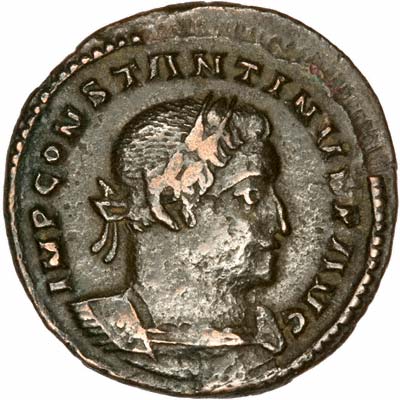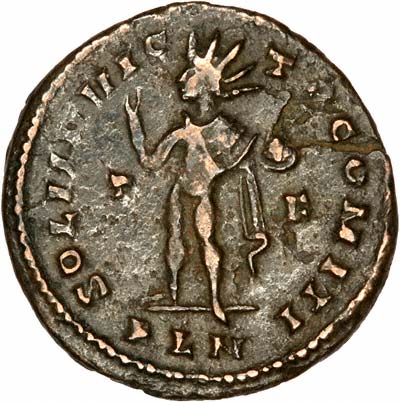| The Very Highest Quality Roman Portraits... |
| Portrait Gallery of Roman Emperors |
 Obverse of London Mint Constantine I Bronze | |
 Reverse of London Mint Constantine I Bronze showing 'Sol Invictus' | |
Early Life
C. Flavius Valerius Constantinus was born in Naissus in what is now modern day Serbia, some time around 272 A.D. His father, Constantius Chlorus, was an officer in the Roman Army and his mother, Helena (also known as St. Helena) was said by some to have been an innkeeper's daughter. During the Tetrarchy Period, during which his father became a Caesar, the young Constantine spent time at the courts of Diocletian and Galerius, partly to receive an education, but also to act as a hostage to ensure his Father's good behaviour. In early 305, Constantine was given leave by Galerius to join his Father who was campaigning in Britain at that time. Constantius was by this point a very sick man, and he died at York the following year, but not before proclaiming that his son should succeed his title of Augustus.
Early Reign
Constantius' old tetrarchic colleagues were not impressed by Constantine's pretensions to purple however, as Severus was already the Caesar appointed to succeed to Constantius in the event of his death. However, as Constantine commanded the loyalty of the large and experienced armies of his father, as well as the provinces of Britannia, Hispania and Gaul, Galerius and his other colleagues thought it wise not to totally reject Constantine's succession. Although they refused to recognise him as Augustus, they were prepared to recognise him as Caesar. Although Constantine was far from satisfied by this, he was prepared to bide his time for now, and focused on building up his reputation by winning a series of victories against the Franks and the Alemanni. An opportunity to advance his cause presented itself when Maxentius, the son of the retired emperor Maximian rose in rebellion against Galerius. Severus II was despatched to deal with the usurper, but was captured and killed by Maxentius in 307. Maxentius brought his father out of retirement, and they offered an alliance with the son of Maximian's old Caesar, and offered to recognise Constantine as an Augustus. This was accepted, but Constantine refused to get involved directly in the struggles in Italy, working instead on building up his popularity by waging war against the barbarians along the Rhine instead of fellow Romans.
Eventually, in 308 an imperial conference was called by Galerius to settle the controversy over the status of the various rival emperors. The former emperor Diocletian himself was called upon to attend in order to help settle the question. At this conference, Constantine was demoted to Caesar, which he refused to accept. Licinius was raised to the rank of Augustus and Maximian was compelled to return to retirement. The conference had settled very little, and a renewal of the contest between the emperors and former emperors was inevitable.
Struggle for Power
By 310, Maximian had fallen out with Maxentius and had fled to the court of Constantine. The following year however, he was accused of plotting against Constantine and forced to commit suicide, that year, Galerius also died. Constantine and Maxentius now contended with each other for supremacy in Rome. Constantine forged an Alliance with Licinius, giving him his sister Constantia in marriage, whilst he himself marched against Maxentius, defeating and killing him at the Battle of Milvian Bridge in 312. The defeat and death of Maxentius left Constantine and Licinius in charge of the Western and Eastern parts of the Empire respectively. They both agreed, at an imperial conference to issue an edict of toleration for Christians in their respective halves.
The relationship between the two co-emperors was not a happy one however, and the two eventually went to war between 316-317, which led to an uneasy peace between the two emperors which lasted for ten years. The emperors went to war with each once again in 324, leading to the defeat of Licinius, whom Constantine had murdered 6 months along with his son later in violation of an agreement to spare his life. Constantine was now the sole ruler of the Roman Empire.
Sole Rule
Constantine had demonstrated a lust for power that would brook no rivals, and this possibly extended even to members of his own family. in 326, Constantine had his own son, Crispus, put to death in circumstances which are not fully understood. The most common narrative of events is that Crispus raped Fausta, Constantine's second wife and Crispus' own stepmother, which caused Constantine to order Crispus' death in a fit of rage. Constantine subsequently imposed the Damnatio Memoriae on his memory, but the plot by Fausta to cause the downfall of Crispus in favour of her own sons, Constantine II, Contantius II and Constans was later uncovered and Constantine had her put to death in turn. However, the problem with this version of events is that Constantine never rehabilitated Crispus after the 'truth' had come to light. Perhaps the truth was that Constantine was threatened by the popularity and capabilities of his eldest son, and saw him as another threat to be dealt with, as were Licinius, Maximian, Maxientus and others before him.
The Founding of Constantinople and Constantine's Death
In 330, Constantine founded the city of Constantinople (City of Constantine, named after himself) on the site of Byzantium. Constantine intended this city to be his new Capital, and in this capacity, it served as the capital of the Eastern (and later Byzantine) Empire until 1453. A series of two commemorative coins featuring Constantinoplis and Roma were issued to commemorate this event (the inclusion of Rome was probably a way of soothing any injured feelings Rome might have at being displaced by a faraway Greek city as the centre of the Empire they had created). Seven years later, in 337, Constantine died, having first been baptised into the Christian faith on his deathbed.
Constantine and Christianity
The most important aspect of Constantine's reign was his promotion of the Christian faith. Constantine had held a deep fascination in the Christian faith since his youth, and although he did not formally become a Christian until just before he died, he had endeavoured to protect and promote it since he first came into power. He ascribed his victory over Maxentius at the Milvian Bridge to a dream he had had, in which a vision of the Christian cross appeared to him and a voice told to him 'in this sign, conquer', which inspired Constantine to order that all his troops shields should be painted with the Chrisitan cross, before defeating his enemy's much larger army. Constantine did seem to hedge his bets with the older pagan religion throughout much of his reign however, whether out of political expediency in not wanting to alienate his pagan supporters, or out of a residual belief in the power of the old gods. His coins contain pagan themes, and pagan gods, particularly the Sun god Sol, and as late as 330, he ordered that pagan as well as Christian ceremonies should be performed to commemorate the founding of Constantinople. He did however, order that all his statues be removed from pagan temples, and even though he did not actively persecute paganism as many of his successors did later, he was undoubtably a true believer. Christianity was a minority religion within the Empire during his day, which made his sympathy for it very much a liability. However, by protecting the Christian faith, and by making it the favoured religion of the Empire, Constantine set the stage for making making Christianity the dominant and almost sole religion in Europe for over a thousand years following the demise of the Roman Empire itself.
Price & Availability:-
| Description | Grade | Price £ | Price $ | Availability |
| Bronze fractional | Fine | £25 | $Ask | Sold |
Roman Emperors Portrait Gallery
You may wish to visit our portrait gallery of Roman emperors. Although it is not complete, we add new and better coins when we can. We are always keen to buy superior quality Roman coins to upgrade our photo gallery.
If you want to find the value of a coin you own, please take a look at our page I've Found An Old Coin, What's It Worth?
| ...at the Lowest Possible Price |
|
32 - 36 Harrowside, Blackpool, Lancashire, FY4 1RJ, England. Telephone (44) - (0) 1253 - 343081 ; Fax 408058; E-mail: info@chards.co.uk The URL for our main page is: https://24carat.co.uk Chard(1964) Ltd |